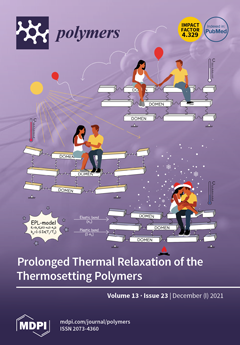Malva parviflora L. is an edible and medicinal herb containing mucilaginous cells in its leaves. Mucilage obtained from
M. parviflora leaves (MLM) was extracted in distilled water (1:10
w/
v) at 70 °C followed by precipitation with alcohol. Preliminary phytochemical tests were performed to assess the purity of the extracted mucilage. Results showed that the yield of mucilage was 7.50%, and it was free from starch, alkaloids, glycosides, saponins, steroids, lipids and heavy metals. MLM had 16.19% carbohydrates, 13.55% proteins and 4.76% amino acids, which indicate its high nutritional value. Physicochemical investigations showed that MLM is neutral and water-soluble, having 5.84% moisture content, 15.60% ash content, 12.33 swelling index, 2.57 g/g water-holding capacity and 2.03 g/g oil-binding capacity. The functional properties, including emulsion capacity, emulsion stability, foaming capacity and stability increased with increased concentrations. Micromeritic properties, such as bulk density, tapped density, Carr’s index, Hausner ratio, and angle of repose, were found to be 0.69 g/cm
3, 0.84 g/cm
3, 17.86%, 1.22 and 28.5, respectively. Scanning electron microscopy (SEM) showed that MLM is an amorphous powder possessing particles of varying size and shape; meanwhile, rheological studies revealed the pseudoplastic behavior of MLM. The thermal transition process of MLM revealed by a differential scanning calorimetry (DSC) thermogram, occurring at a reasonable enthalpy change (∆H), reflects its good thermal stability. The presence of functional groups characteristic of polysaccharides was ascertained by the infrared (IR) and gas chromatography/mass spectrometry (GC/MS) analyses. GC revealed the presence of five neutral monosaccharides; namely, galactose, rhamnose, arabinose, glucose and mannose, showing 51.09, 10.24, 8.90, 1.80 and 0.90 mg/g of MLM, respectively. Meanwhile, galacturonic acid is the only detected acidic monosaccharide, forming 15.06 mg/g of MLM. It showed noticeable antioxidant activity against the DPPH (1,1-diphenyl-2-picrylhydrazyl) radical with an IC
50 value of 154.27 µg/mL. It also prevented oxidative damage to DNA caused by the Fenton reagent, as visualized in gel documentation system. The sun protection factor was found to be 10.93 ± 0.15 at 400 µg/mL. Thus, MLM can be used in food, cosmetic and pharmaceutical industry and as a therapeutic agent due to its unique properties.
Full article






